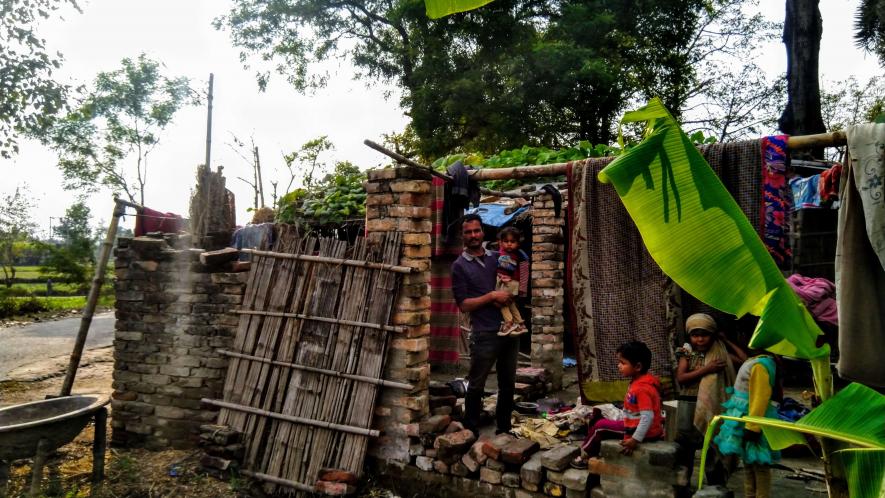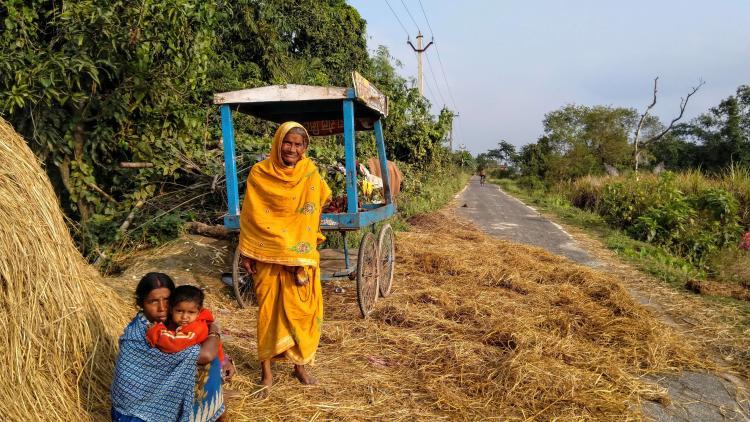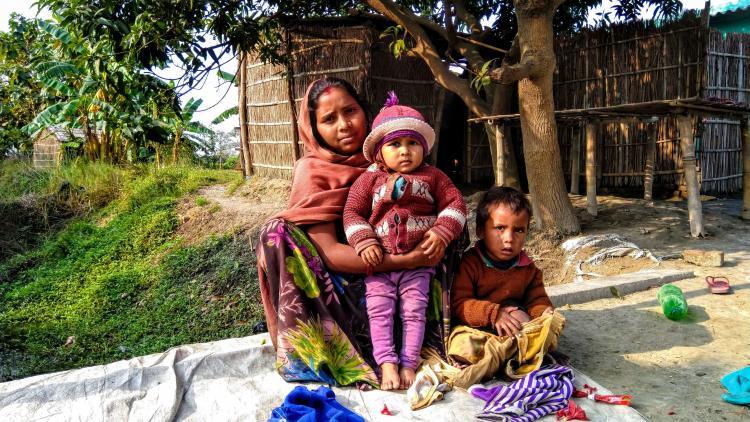Testing Times for the Landless Poor in Bihar’s Champaran

Dinesh with his children.
Satiya Musmat, a widow, does not know how old she is. She assumes to herself that she is a sexagenarian. Perhaps, she lost a trove of documents in the arduous process to get a few dhurs of land. To add to her woes, she also could not succeed in getting a piece of land in her name. She also lost her husband Shivnath Raut two years ago to a sudden paralysis.
Further, Shivnath’s death indebted his family. “My son gathered loans from various places to perform his last rites. We are religious; we had to do this somehow. He did not leave a treasure for us. What could he do? He was just a ploughman,” Satiya says.
Bihar’s Chief Minister Nitish Kumar has repeatedly promised that landless people would be allotted land. Earlier this year, a state policy was devised on the periphery of Pradhan Mantri Awas Yojana-Gramin or PMAY-Gramin to support each landless beneficiary with Rs. 60,000. That also included a plan to “pay an additional support of Rs. 1.20 lakh” for the construction of a pucca house. However, problems faced by many landless poor like Satiya, despite all their personal efforts, remain the same.
Satiya was wedded to Shivnath Raut of a remote village called Loharpatti. They were always landless as far as Satiya can remember, albeit faintly. But earlier, they could live on an abandoned piece of land of upper caste Brahmins of Loharpatti. As time progressed, the landholders evicted Satiya’s family. They were not ousted from the panchayat or village cluster, as they had voting rights. They first lived in the house of one Jangbahadur Mahto; they were further relocated to a place near the bridge constructed over a Gandak rivulet. Devendra Rai, local Mukhiya, then allowed them to live on the distant bank of a water canal. Since then, the family is at the mercy of Mukhiya, the post which keeps switching among the dominant castes of this panchayat where Satiya’s Kurmi caste, also OBC, is the marginalised other.
Like her husband, Satiya never received old age pension. Until recently, she was not a ration beneficiary. However, voting cards [Electors Photo Identity Card or EPIC] have been issued to all eligible voters of her family. Son Lalbabu Raut, still landless, lives in Loharpatti while Satiya lives with younger son Vikram Raut.
Vikram, in his early forties, is a daily wage labourer. He pulls a rented handcart or thelagadi in Bettiah town. On the day this reporter visited his home, Vikram had left for the work at 9 am. and he was expected to return by 6 pm with a daily income of Rs. 300.
“How will he be able to return loans with his insignificant earnings?” asks Satiya. “Government knows that we exist but only to vote.”
“Gaun me jamin, na sareh me khet (Neither a house lot in hand nor any agricultural land to claim).”
“Ghar ke maral sareh me gaeni, kar me lag gael aag. Uhan ke maral ghar me aaeni. (After knowing that the fire was devastating crop in the field, I ran to extinguish the blaze. Then I learnt that my house was burning too. Alas! My fortune was immolated).”
These proverbs spoken by Satiya narrating nuances of the rural lives in Bhojpur region are unique to their language while they are close to a fourteenth century saying in English “misfortunes never come singly”.
Satiya’s community comprises traditional sharecroppers; they are continuing this age-old practice. What they practise today is aadhiya bataiya. Unlike hunda bataiya, another kind of land tenancy in which rent must be paid in cash and not crop, landowner receives half of the produce in aadhiya bataiya. This diminishes their difficulties to an extent; however, that does not completely obviate all their issues as all the loss in farming is theirs. “Flash floods this year gutted our paddy crops. We had invested Rs 7,000 in 10 kattha of agricultural land which we had rented,” says Seema Devi, Vikram’s wife. They have now sowed wheat in this field.
Seema also works as an agricultural labourer in the fields, but gender pay disparity worsens the situation for women labourers. She says, “I receive Rs 120 for the job which would yield Rs 250 if it would have been done by a man. Even then, agricultural labour is seasonal and restrictive as we mostly engage in tasks available in our village.”
Another source of subsistence for the family—comprising Sakiya, families of Sakiya’s son Vikram and Vikram’s sister Sheela—is a rented cow. The cow is milked two times a day; the owner of the cow and the joint family of Sakiya share cow’s milk equally. If the cow and her calves are sold in future, one-third of price will be paid to Sakiya and rest will go to the owner. They cannot afford a cow as a healthy cow’s minimum market value is Rs 15,000, which will incur additional loan. “We bought a tractor-trolley of hay-silage for cow for Rs 800 and packaged cattle fodder for Rs 800. Chaff cutter or ledi katta cost us Rs. 12,000 which we got with an informal loan,” says Seema, adding that “these are difficult times.”

Seema [left, with her child] and Sakiya basking in the sun while the hay, used as cattle seat in the night, spread on the road to dry. One of the handcarts stands behind Sakiya.
“It is very difficult for us to cross this drenched canal in rainy season. We must take a different route which forces us to cross an extra kilometre,” says Sapna Devi, 20 years old daughter-in-law of Sakiya’s daughter, Sheela. Sapna doesn’t come from a rich family; financial condition at her mother’s home, she says, is equally bad. She adds, “My grandfather left 2 kattha of land for his four sons. This way, my father inherited only 10 dhurs of land. We are four sisters and a brother. My father used to go to other states in search of manual jobs; he was there earning monthly income of Rs 10,000. We luckily did not starve. He has been at home for the past one year. Other sisters are yet to get married […]”
Like Sakiya’s thatched hut, Sapna’s hut sits on an area of about 6ft x 6 ft. “Each bamboo pole costs Rs 150. Some ten bamboos were purchased. Now, you can estimate how much did we spend on this. Don’t forget to include the labour cost of gharami [people whose caste occupation is to thatch kuchha houses]; they take Rs 450 for a day-job. And this structure doesn’t last for long,” says Sapna, further clarifying that the maximum lifetime of the hut is “two years”. The reason behind the collapse of this structure is the rainy season; water logging results in the decomposition of bamboos—doused in mud—in the base of structure. Conventionally, climbers, like bottle gourd, are grown for subsistence on the thatched roof.
Sakiya demonstrates how risky is it for her and others to cross the canal.
Sapna has studied till class VII, but she couldn’t continue her education. A mother of a kid, she is hopeful about her child’s education, but is still apprehensive. Her elder child succumbed to a cardiac issue a month ago. She says that doctors told them that “the child had a hole in the heart”. “We spent Rs. 20,000 on her illness but her situation worsened. Nine private doctors discharged her, admitting that medical treatment was not possible in the town.” When asked about the government medical facility, she says, “The doctors there also discharged my kid.” She alleges that the doctors from the government hospital did not refer the patient to another facility in the state. And now, the debts have piled up. “But there is no option. On every eighth day, Rs. 750 should be compulsorily returned to the moneylender. Usually, upper caste men lend the money,” she says. In the poverty-ridden area, this seems to be a successful side business.
We walk two kilometres towards the East to meet another homeless family in the village called Pokharbhinda.
A decade ago, this family migrated from a remote area near Bagaha Dam. “Water was released from the Dam. It eventually submerged our village. That became an annual occurrence. So, the family had to migrate.” says Sunaina Devi, who is alone at her home. Her mother-in-law is grazing goats in a nearby field.
Sunaina says that the local people are forcing her family to leave this place. “Each time a petty issue arises, locals threaten to evict us,” she says.
Again, like in the case of Sakiya, Sunaina’s family members too have Aadhaar and EPIC on this address; they, by contrast, do not have rights on minimum guarantees like Public Distribution System (PDS) and Anganwadi Centre (ICDS-SNP).
Sunaina received 0.5 kg of pulses, 1 bowl of soya bean, 1 egg, as monthly supplementary nutrition for her child Deepak Kumar for a year. Anganwadi Worker (AWW) has allegedly asked Sunaina not to visit the centre again, as Sunaina’s child turns one this month. The provisions for delivery of supplementary nutrition programme for Pregnant & Lactating Mothers (P&LM) are allegedly distorted by AWWs, as was also seen in the case of Sapna Devi of adjacent village.
Sunaina’s husband Paras Sharma works as a manual navvy and earns Rs. 300 on average each day. Sunaina tells NewsClick that they have not received any flood recovery payment.
Paras Sharma’s sister Babita was married earlier this year, Sunaina adds. “Their [referring to in-laws of Babita] demand was a motorbike [worth Rs. 70,000]. For this marriage, we took an informal loan of Rs. 2,00,000 which is yet to be repaid.” Asked about the age and qualification of Babita, Sunaina says, “She had just matriculated.” Further, Sunaina confirms that Babita discontinued education after marriage.

Sunaina Devi with her kids.
We meet another landless family in Rampur village, two kilometres away from the village of Pokharbhinda.
Last year, Dinesh Patel laid the foundation of his house with the money he had earned in Kashmir, but it was halted, when he feared eviction.
Circumstances have reduced landless poor to mere voters. The Bihar Land Reforms (Fixation of Ceiling Area and Acquisition of Surplus Land) Act [including amended versions of this act] has not benefited the deserving candidates here. Lack of education and sensitisation on different fronts has left social evils untouched too. The issue compassing major concerns like family planning and gender equality and sentience of labour rights against unduly low pay is wide open.
Dinesh Patel, in his thirties, is a father of six daughters. He works as a painting labourer. On this job, he receives Rs 300 a day, he says, “I was in Kashmir a few years ago. There, I made a minimum of Rs. 1,000 each day. But I can’t go back to Kashmir now. How will my wife look after the children alone?”
“I had a desire for a boy child who could look after us in old age. Unfortunately, that did not happen,” he continues. “My parents settled here. This is some 3 dhur of land. An officer from Block visited us earlier this year. He took some photographs, but we haven’t received any funds under housing scheme. Nor any token for this piece of land has been generated.”
Dinesh owns a cow and some goats. Dinesh has taken a loan of Rs. 40,000. He makes a weekly payment of Rs. 900 in order to mitigate loans.
No landless family this reporter talked to had any idea of the new policy by the Bihar Government under PMAY-Gramin.
Get the latest reports & analysis with people's perspective on Protests, movements & deep analytical videos, discussions of the current affairs in your Telegram app. Subscribe to NewsClick's Telegram channel & get Real-Time updates on stories, as they get published on our website.
























